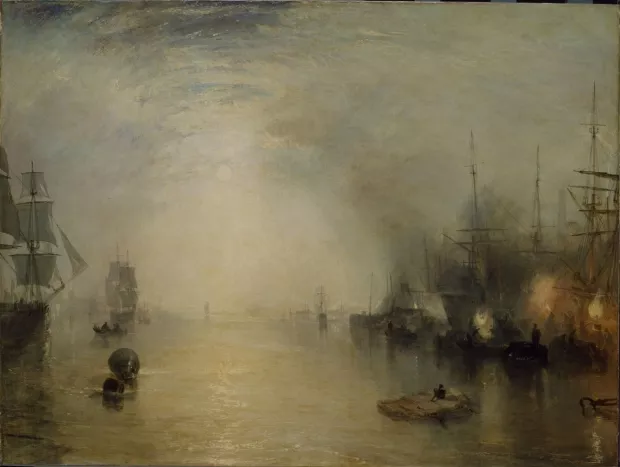Creation Date
1835
Height
92 cm
Width
123 cm
Medium
Genre
Description
Keelmen Heaving Coals by Midnight was comissioned by cotton-spinner Henry McConnell along with the painting Venice: The Dogana and San Giorgio Maggiore. It was meant to show Britain's rise as a mercantile power beside the decline of the once dominating Venice (J. Hamilton, Late Seascapes 31, 34). “To the right, the keelmen and the dark, flat-bottomed keels that carried the coal from Northumberland and Durham down the River Tyne are silhouetted against the orange and white flames from the torches, as the coal is transferred to the sailing ships. To the left, square riggers wait to sail out on the morning tide. Behind these ships Turner suggested the distant cluster of factories and ships with touches of gray paint and a few thin lines.”
Turner uses Romantic elements here to transform the ordinary into the poetic and the mysterious; this painting exemplifies how the subject of the sea lends itself to such a transformation. For example, "the artist used light to obliterate and liberate forms so that they could exist in poetic strangeness” (conservation notes). Furthermore, this scene hints at Turner's belief that humanity was part of nature, “that the source of well-being lay in the harmonious relation of man with his environment” (conservation notes); in this case, the human toil and smut of the Industrial Revolution combine with the natural setting of the sea.
The keelmen in this painting are loading Tyne coal from the barges (keels) which traveled “around the clock” in order to provide Londoners with enough coal to keep them “luxuriously warm.” Like the gondolas in Venice: The Dogana and San Giorgio Maggiore, the barges are portrayed as flat-bottomed; however, despite this similarity in form, the barges serve as images of hard labor that contrast with the gondolas floating lazily in the Grand Canal. This contrast exemplifies some of the English national pride and international competition that was associated with seascapes in the Romantic era (Hamilton 34).
Turner’s use of Romantic elements gives beauty and significance to the industrial subject of this painting. The moon shines brightly through the clouds, so that the back of the image is obscured in light. The smoke on the right and the blinding light of the moon, combined with the generally foggy atmosphere of the painting, obscures the ordinary objects on the water, such as the ropes and torches, and makes them more abstract. The conservation notes inform us that
[t]ypical to Turner’s approach to painting, the basic elements of nature fuse; earth, air, fire, and water meld here under the luminous beams of the moon. Although the coolness of the light denotes a nighttime view, there is little sense of darkness. The artist has transformed nature with a flooding, all-pervasive moonlight.
Another commentator observes:
A common factor in this pendant pair (Keelemen Heaving Coals by Moonlight and Venice:The Dogana and San Giorgio Maggiore) as in many sea or river paintings by Turner, is the open foreground defined by gathering boats, which adds to the illusion of the stage, where figures fall back to await, or participate in, a coming action. (Hamilton 34)
Associated Works
Copyright
Copyright, 2009, Romantic Circles.
Collection
Accession Number
1942.9.86
Additional Information
Bibliography
Brook-Hart, Denys. British 19th Century Marine Painting. Suffolk: Baron, 1974. Print.
Butlin, Martin and Evelyn Joll. The Paintings of J.M.W. Turner. New Haven: Yale UP, 1984. Print.
Hamilton, James. Turner: The Late Seascapes. New Haven: Yale UP, 2003. Print.
Hayes, John. British Paintings of the 16th through 19th Centuries. New York: Cambridge UP, 1991. Print.
Tracy, Nicholas. Britannia's Palette: The Arts of Naval Victory. Montreal: McGill-Queen's UP, 2007. Print.
Widener Collection, National Gallery of Art, Washington D.C.

